Zitang Zhou
NTIRE 2025 challenge on Text to Image Generation Model Quality Assessment
May 22, 2025Abstract:This paper reports on the NTIRE 2025 challenge on Text to Image (T2I) generation model quality assessment, which will be held in conjunction with the New Trends in Image Restoration and Enhancement Workshop (NTIRE) at CVPR 2025. The aim of this challenge is to address the fine-grained quality assessment of text-to-image generation models. This challenge evaluates text-to-image models from two aspects: image-text alignment and image structural distortion detection, and is divided into the alignment track and the structural track. The alignment track uses the EvalMuse-40K, which contains around 40K AI-Generated Images (AIGIs) generated by 20 popular generative models. The alignment track has a total of 371 registered participants. A total of 1,883 submissions are received in the development phase, and 507 submissions are received in the test phase. Finally, 12 participating teams submitted their models and fact sheets. The structure track uses the EvalMuse-Structure, which contains 10,000 AI-Generated Images (AIGIs) with corresponding structural distortion mask. A total of 211 participants have registered in the structure track. A total of 1155 submissions are received in the development phase, and 487 submissions are received in the test phase. Finally, 8 participating teams submitted their models and fact sheets. Almost all methods have achieved better results than baseline methods, and the winning methods in both tracks have demonstrated superior prediction performance on T2I model quality assessment.
EgoLife: Towards Egocentric Life Assistant
Mar 05, 2025Abstract:We introduce EgoLife, a project to develop an egocentric life assistant that accompanies and enhances personal efficiency through AI-powered wearable glasses. To lay the foundation for this assistant, we conducted a comprehensive data collection study where six participants lived together for one week, continuously recording their daily activities - including discussions, shopping, cooking, socializing, and entertainment - using AI glasses for multimodal egocentric video capture, along with synchronized third-person-view video references. This effort resulted in the EgoLife Dataset, a comprehensive 300-hour egocentric, interpersonal, multiview, and multimodal daily life dataset with intensive annotation. Leveraging this dataset, we introduce EgoLifeQA, a suite of long-context, life-oriented question-answering tasks designed to provide meaningful assistance in daily life by addressing practical questions such as recalling past relevant events, monitoring health habits, and offering personalized recommendations. To address the key technical challenges of (1) developing robust visual-audio models for egocentric data, (2) enabling identity recognition, and (3) facilitating long-context question answering over extensive temporal information, we introduce EgoButler, an integrated system comprising EgoGPT and EgoRAG. EgoGPT is an omni-modal model trained on egocentric datasets, achieving state-of-the-art performance on egocentric video understanding. EgoRAG is a retrieval-based component that supports answering ultra-long-context questions. Our experimental studies verify their working mechanisms and reveal critical factors and bottlenecks, guiding future improvements. By releasing our datasets, models, and benchmarks, we aim to stimulate further research in egocentric AI assistants.
HarmonySet: A Comprehensive Dataset for Understanding Video-Music Semantic Alignment and Temporal Synchronization
Mar 04, 2025


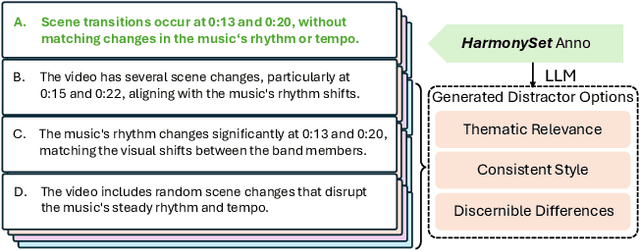
Abstract:This paper introduces HarmonySet, a comprehensive dataset designed to advance video-music understanding. HarmonySet consists of 48,328 diverse video-music pairs, annotated with detailed information on rhythmic synchronization, emotional alignment, thematic coherence, and cultural relevance. We propose a multi-step human-machine collaborative framework for efficient annotation, combining human insights with machine-generated descriptions to identify key transitions and assess alignment across multiple dimensions. Additionally, we introduce a novel evaluation framework with tasks and metrics to assess the multi-dimensional alignment of video and music, including rhythm, emotion, theme, and cultural context. Our extensive experiments demonstrate that HarmonySet, along with the proposed evaluation framework, significantly improves the ability of multimodal models to capture and analyze the intricate relationships between video and music.
FunQA: Towards Surprising Video Comprehension
Jun 26, 2023
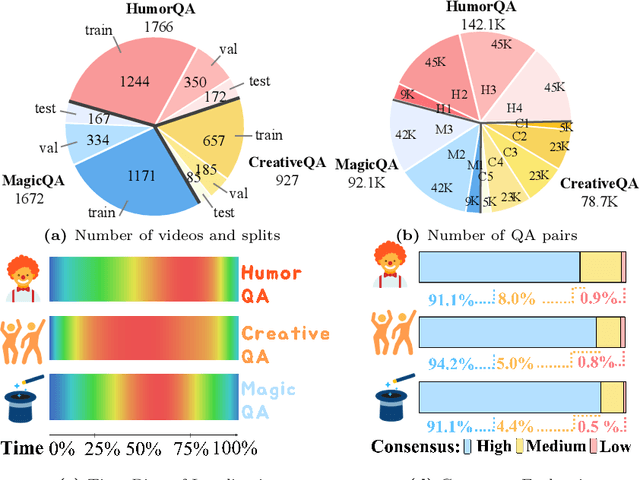

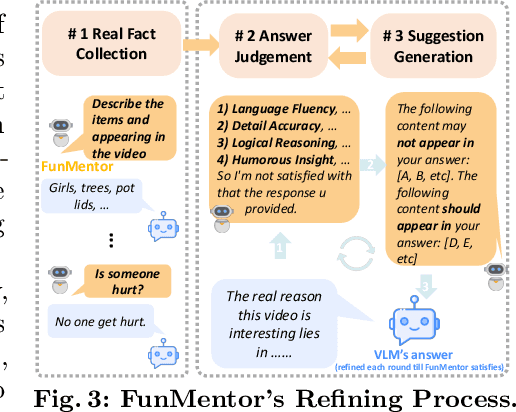
Abstract:Surprising videos, e.g., funny clips, creative performances, or visual illusions, attract significant attention. Enjoyment of these videos is not simply a response to visual stimuli; rather, it hinges on the human capacity to understand (and appreciate) commonsense violations depicted in these videos. We introduce FunQA, a challenging video question answering (QA) dataset specifically designed to evaluate and enhance the depth of video reasoning based on counter-intuitive and fun videos. Unlike most video QA benchmarks which focus on less surprising contexts, e.g., cooking or instructional videos, FunQA covers three previously unexplored types of surprising videos: 1) HumorQA, 2) CreativeQA, and 3) MagicQA. For each subset, we establish rigorous QA tasks designed to assess the model's capability in counter-intuitive timestamp localization, detailed video description, and reasoning around counter-intuitiveness. We also pose higher-level tasks, such as attributing a fitting and vivid title to the video, and scoring the video creativity. In total, the FunQA benchmark consists of 312K free-text QA pairs derived from 4.3K video clips, spanning a total of 24 video hours. Extensive experiments with existing VideoQA models reveal significant performance gaps for the FunQA videos across spatial-temporal reasoning, visual-centered reasoning, and free-text generation.
OpenOOD: Benchmarking Generalized Out-of-Distribution Detection
Oct 13, 2022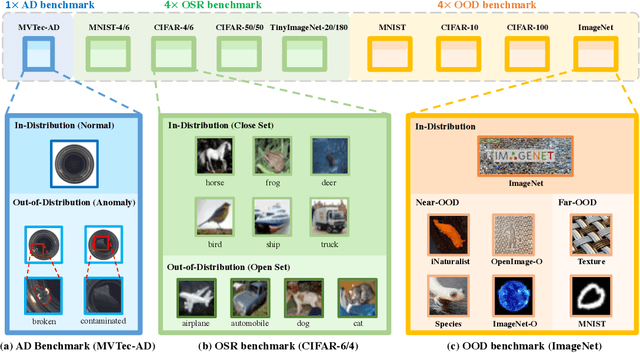
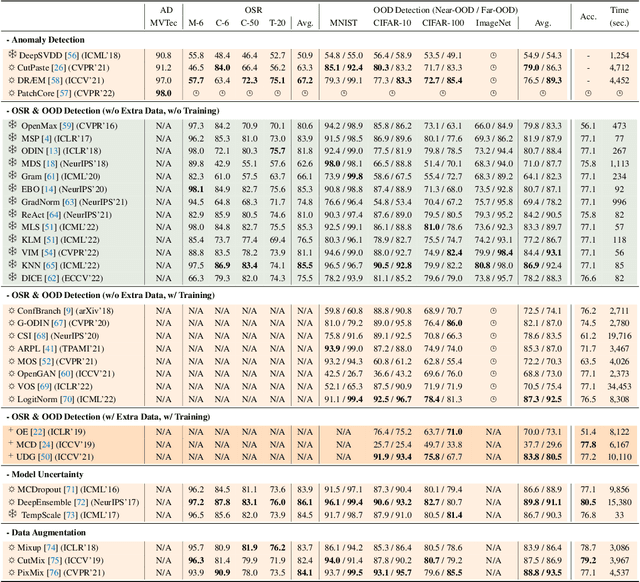

Abstract:Out-of-distribution (OOD) detection is vital to safety-critical machine learning applications and has thus been extensively studied, with a plethora of methods developed in the literature. However, the field currently lacks a unified, strictly formulated, and comprehensive benchmark, which often results in unfair comparisons and inconclusive results. From the problem setting perspective, OOD detection is closely related to neighboring fields including anomaly detection (AD), open set recognition (OSR), and model uncertainty, since methods developed for one domain are often applicable to each other. To help the community to improve the evaluation and advance, we build a unified, well-structured codebase called OpenOOD, which implements over 30 methods developed in relevant fields and provides a comprehensive benchmark under the recently proposed generalized OOD detection framework. With a comprehensive comparison of these methods, we are gratified that the field has progressed significantly over the past few years, where both preprocessing methods and the orthogonal post-hoc methods show strong potential.
 Add to Chrome
Add to Chrome Add to Firefox
Add to Firefox Add to Edge
Add to Edge